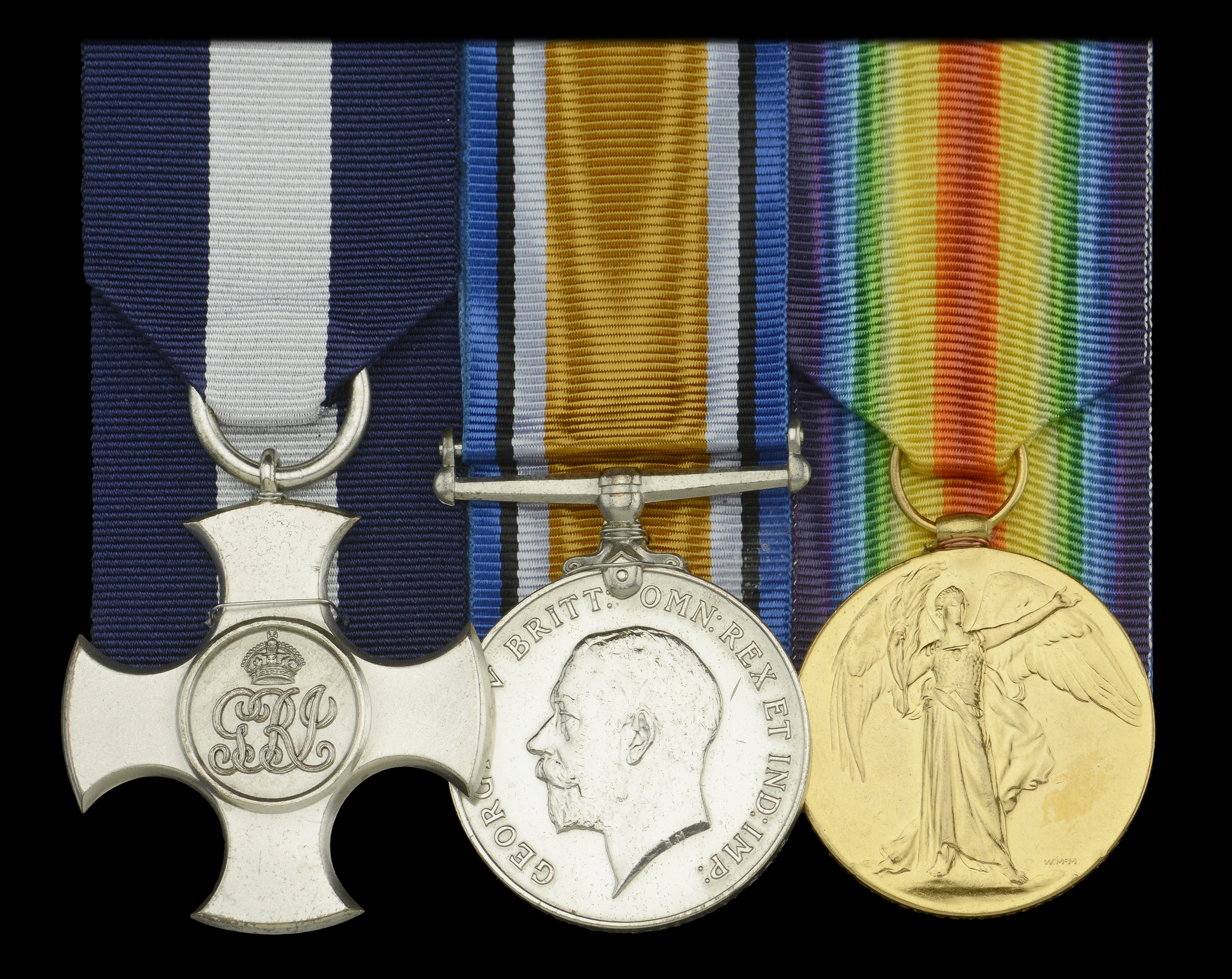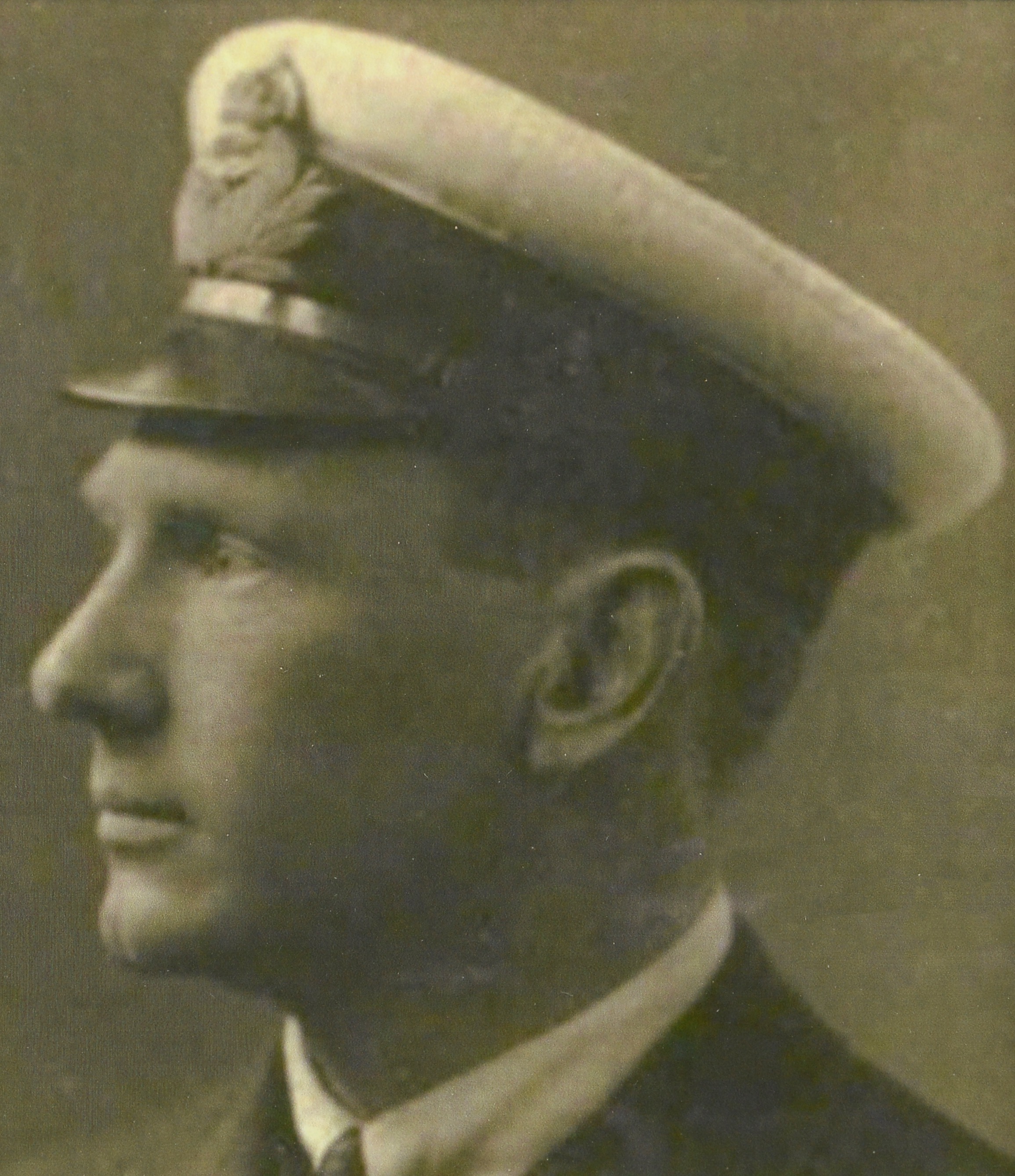74
A scarce Great War '1917' Henri Farman pilot's D.S.C. group of three awarded to Captain C....
Bids do not include VAT, buyer’s premium or delivery.
By confirming your bid, you agree that you have read and accepted the-saleroom.com and the auctioneer's terms and conditions. Confirming your bid is a legally binding obligation to purchase and pay for the lot should your bid be successful.
Choose one of the quick bid options below:
Bids do not include VAT, buyer’s premium or delivery.
By confirming your bid, you agree that you have read and accepted the-saleroom.com and the auctioneer's terms and conditions. Confirming your bid is a legally binding obligation to purchase and pay for the lot should your bid be successful.
Distinguished Service Cross, G.V.R., hallmarks for London ‘1918’, unnamed as issued; British War and Victory Medals (Capt. C. A. Maitland-Heriot. R.A.F.) mounted on card for display with photographic image of recipient and of aircraft, very fine (3) £1,200-£1,600
---
D.S.C. London Gazette 22 June 1917:
‘In recognition of their services in a bombing attack on the Kuleli Burgas Bridge on the 4th January 1917, when several direct hits were scored and considerable damage done. The machines were exposed to anti-aircraft, rifle and machine gun fire during the attack, and also on the return journey.’
Charles Adrian Maitland-Heriot was born in August 1886, and was the son of F. M. Heriot. He ‘was educated at Bradfield College and the Armstrong College of Science, Newcastle upon Tyne, and served his apprenticeship between 1904 and 1908 at the North Eastern Marine Engineering Works and with Messrs. Bott and Stennett, Ltd. He began his career in Argentina in 1909 with the post of assistant engineer to contractors engaged upon the construction of branch lines for the Central Argentine Railway and subsequently was in charge of irrigation works. In 1912 he went into business on his own account and established the firm of Messrs. Adrian M. Heriot and Company, contractors, for whom he acted as general manager and later as managing director. His activities were chiefly directed to railway construction, of which he was in charge for the contractors. During the 1914-18 war he saw service with the Royal Naval Air Service and the Royal Air Force.’ (Institution of Mechanical Engineers Obituaries 1951 refers)
Maitland-Heriot returned to the UK with the outbreak of the Great War, and was commissioned Sub-Lieutenant in the Royal Naval Volunteer Reserve, 5 February 1915. He served with the Armoured Car Division (entitled to 1914-15 Star), this formation grew out of a scouting and aircraft recovery unit maintained by the R.N.V.R. which was outfitted with machine guns and armour in late 1914 for a more attacking role. Trench warfare in France and Belgium prevented the use of these vehicles, and in mid-1915 they were transferred to the command of the Army. Maitland-Heriot transferred to the Royal Naval Air Serve in June 1915, and under took pilot training. He gained his Royal Aero Club Certificate from Eastbourne, 31 July 1915.
Maitland-Heriot was posted as a Flight Lieutenant for operational flying with No. 2 Wing in the Aegean, in October 1915. Nos. 2 and 3 Wings flew from Imbros, primarily focussed on reconnaissance and artillery spotting duties. Maitland-Heriot flew Henri Farman HF20’s on operations against Turkish and Bulgarian targets. The attack on the Kuleli Burgas Railway Bridge, 4 January 1917, was carried out by three Henri Farman light bombers, causing great damage to the span which was a valuable supply route between the Turks and their allies in Central Europe.
Maitland-Heriot did not have long to bask in the success of the raid, as he was shot down flying Henri Farman F27 N3021 over the seaport Canakkale, 12 February 1917. Maitland-Heriot, flying with Flight Lieutenant W. C. Jameson as his observer, became the second victim of the German Fighter Ace Leutnant Emil Meinecke. Both Maitland-Heriot and and Jameson survived being shot down, and were taken prisoner of war. Maitland-Heriot advanced to Captain and transferred to the Royal Air Force whilst interned as a POW. He was repatriated in December 1918, and demobilised in May the following year.
After the war he returned to Argentina, and ‘for the last thirteen years of his life he was working in the south of the Argentine, on roads, irrigation canals, and airfields. Mr. Heriot was elected a Graduate of the Institution in 1907, and transferred to Associate Membership in 1915. He was also an Associate Member of the Institution of Civil Engineers.... [having] spent the whole of his professional career in Argentina, where his death occurred on 26th July 1950, at the age of sixty-three.’ (Ibid)
Sold with copied research, including photographic image of recipient.
Distinguished Service Cross, G.V.R., hallmarks for London ‘1918’, unnamed as issued; British War and Victory Medals (Capt. C. A. Maitland-Heriot. R.A.F.) mounted on card for display with photographic image of recipient and of aircraft, very fine (3) £1,200-£1,600
---
D.S.C. London Gazette 22 June 1917:
‘In recognition of their services in a bombing attack on the Kuleli Burgas Bridge on the 4th January 1917, when several direct hits were scored and considerable damage done. The machines were exposed to anti-aircraft, rifle and machine gun fire during the attack, and also on the return journey.’
Charles Adrian Maitland-Heriot was born in August 1886, and was the son of F. M. Heriot. He ‘was educated at Bradfield College and the Armstrong College of Science, Newcastle upon Tyne, and served his apprenticeship between 1904 and 1908 at the North Eastern Marine Engineering Works and with Messrs. Bott and Stennett, Ltd. He began his career in Argentina in 1909 with the post of assistant engineer to contractors engaged upon the construction of branch lines for the Central Argentine Railway and subsequently was in charge of irrigation works. In 1912 he went into business on his own account and established the firm of Messrs. Adrian M. Heriot and Company, contractors, for whom he acted as general manager and later as managing director. His activities were chiefly directed to railway construction, of which he was in charge for the contractors. During the 1914-18 war he saw service with the Royal Naval Air Service and the Royal Air Force.’ (Institution of Mechanical Engineers Obituaries 1951 refers)
Maitland-Heriot returned to the UK with the outbreak of the Great War, and was commissioned Sub-Lieutenant in the Royal Naval Volunteer Reserve, 5 February 1915. He served with the Armoured Car Division (entitled to 1914-15 Star), this formation grew out of a scouting and aircraft recovery unit maintained by the R.N.V.R. which was outfitted with machine guns and armour in late 1914 for a more attacking role. Trench warfare in France and Belgium prevented the use of these vehicles, and in mid-1915 they were transferred to the command of the Army. Maitland-Heriot transferred to the Royal Naval Air Serve in June 1915, and under took pilot training. He gained his Royal Aero Club Certificate from Eastbourne, 31 July 1915.
Maitland-Heriot was posted as a Flight Lieutenant for operational flying with No. 2 Wing in the Aegean, in October 1915. Nos. 2 and 3 Wings flew from Imbros, primarily focussed on reconnaissance and artillery spotting duties. Maitland-Heriot flew Henri Farman HF20’s on operations against Turkish and Bulgarian targets. The attack on the Kuleli Burgas Railway Bridge, 4 January 1917, was carried out by three Henri Farman light bombers, causing great damage to the span which was a valuable supply route between the Turks and their allies in Central Europe.
Maitland-Heriot did not have long to bask in the success of the raid, as he was shot down flying Henri Farman F27 N3021 over the seaport Canakkale, 12 February 1917. Maitland-Heriot, flying with Flight Lieutenant W. C. Jameson as his observer, became the second victim of the German Fighter Ace Leutnant Emil Meinecke. Both Maitland-Heriot and and Jameson survived being shot down, and were taken prisoner of war. Maitland-Heriot advanced to Captain and transferred to the Royal Air Force whilst interned as a POW. He was repatriated in December 1918, and demobilised in May the following year.
After the war he returned to Argentina, and ‘for the last thirteen years of his life he was working in the south of the Argentine, on roads, irrigation canals, and airfields. Mr. Heriot was elected a Graduate of the Institution in 1907, and transferred to Associate Membership in 1915. He was also an Associate Member of the Institution of Civil Engineers.... [having] spent the whole of his professional career in Argentina, where his death occurred on 26th July 1950, at the age of sixty-three.’ (Ibid)
Sold with copied research, including photographic image of recipient.
Orders, Decorations, Medals and Militaria
Sale Date(s)
Venue Address
General delivery information available from the auctioneer
If you are successful in purchasing lot/s being auctioned by us and opt for the item/s to be sent to you, we will use the following methods of shipment:
Within the UK
If you live within the UK, items will be despatched using Royal Mail Special Delivery. This service provides parcel tracking (via the Royal Mail website) and next weekday delivery (betwen 9am and 1pm). Items delivered within the UK are covered by our insurance company. Heavy and bulky lots will be sent by courier, in discussion with the client.
Outside of the UK
If the item/s being sent are worth under £1000 in total they are sent using Royal Mail’s Signed For International service. This ensures the item must be signed for when it is delivered.
If the item/s being sent are valued at over £1000 in total they will be sent using FedEx. This service allows next day delivery to customers in many parts of the US and parcels are fully trackable using the FedEx website.
Shipping Exceptions
Certain lots such as those containing glass or sharp implements, etc., may not be suitable for in-house shipping within or outside of the UK. Please contact Noonans with any queries.
Important Information
Auctioneer's Buyers Premium: 24% (+VAT)
There is an additional charge of 4.95% (+VAT/sales tax)














